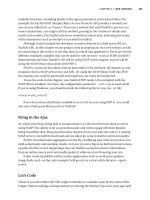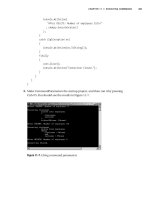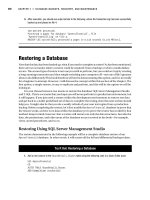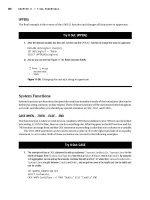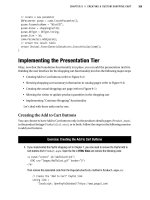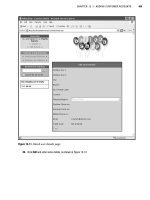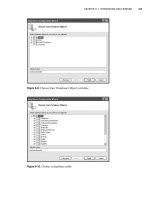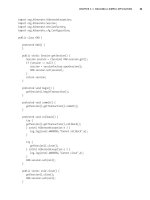Beginning Java SE 6 Platform From Novice to Professional phần 6 pptx
Bạn đang xem bản rút gọn của tài liệu. Xem và tải ngay bản đầy đủ của tài liệu tại đây (598.59 KB, 51 trang )
for (String option: options)
System.out.println (option);
}
}
The source code introduces public static void agentmain(String agentArgs,
Instrumentation inst) as the entry point into the agent. According to the JDK 6 docu-
mentation for the
java.lang.instrument package (introduced by Java 5), it is likely that
an application will be running and its
public static void main(String [] args) method
will have been invoked before the virtual machine invokes
agentmain().
■Note According to the JDK documentation, the target virtual machine will attempt to locate and invoke a
public static void agentmain(String agentArgs) method if it cannot locate public static void
agentmain(String agentArgs, Instrumentation inst)
. If it cannot find this fallback method, the
target virtual machine and its application will keep running, without the agent running in the background.
The target virtual machine/application will also keep running if either
agentmain() method throws an
exception; the uncaught exception is ignored.
The
agentmain() method specifies a String parameter that identifies any arguments
passed to this method. These arguments originate from the arguments string passed to
options in loadAgent(String agent, String options) (described in Table 7-2). Because the
arguments are combined into a single string, the agent is responsible for parsing them.
BasicAgent refers to these arguments as options.
After compiling the agent’s source code (
javac BasicAgent.java), the resulting class
file must be stored in a JAR file. As stated in the JDK documentation, this JAR file’s mani-
fest must contain an
Agent-Class attribute that identifies the class containing an
agentmain() method. Listing 7-4 presents a suitable manifest file with the Agent-Class
attribute for the agent’s JAR file.
Listing 7-4. manifest.mf
Agent-Class: BasicAgent
After creating a basicAgent.jar file via jar cvfm basicAgent.jar manifest.mf
BasicAgent.class (or a similar command), you are almost ready to use the Attach API to
load the JAR file’s agent into a target virtual machine. To accomplish this task, I’ve created
an attach application, whose source code appears in Listing 7-5.
CHAPTER 7 ■ MONITORING AND MANAGEMENT232
830-X CH07.qxd 9/20/07 2:01 PM Page 232
Listing 7-5. BasicAttach.java
// BasicAttach.java
// Unix compile : javac -cp $JAVA_HOME/lib/tools.jar BasicAttach.java
//
// Windows compile: javac -cp %JAVA_HOME%/lib/tools.jar BasicAttach.java
import java.io.*;
import java.util.*;
import com.sun.tools.attach.*;
public class BasicAttach
{
public static void main (String [] args) throws Exception
{
if (args.length != 1)
{
System.err.println ("Unix usage : "+
"java -cp $JAVA_HOME/lib/tools.jar:. "+
"BasicAttach appmainclassname");
System.err.println ();
System.err.println ("Windows usage: "+
"java -cp %JAVA_HOME%/lib/tools.jar;. "+
"BasicAttach appmainclassname");
return;
}
// Return a list of running virtual machines to which we can potentially
// attach.
List<VirtualMachineDescriptor> vmds = VirtualMachine.list ();
// Search this list for the virtual machine whose display name matches
// the name passed to this application as a command-line argument.
for (VirtualMachineDescriptor vmd: vmds)
if (vmd.displayName ().equals (args [0]))
{
// Attempt to attach.
CHAPTER 7 ■ MONITORING AND MANAGEMENT 233
830-X CH07.qxd 9/20/07 2:01 PM Page 233
VirtualMachine vm = VirtualMachine.attach (vmd.id ());
// Identify the location and name of the agent JAR file to
// load. The location is relative to the target virtual machine
// not the virtual machine running BasicAttach. The location
// and JAR name are passed to the target virtual machine, which
// (in this case) is responsible for loading the basicAgent.jar
// file from the location.
String agent = vm.getSystemProperties ()
.getProperty ("java.home")+File.separator+
"lib"+File.separator+"basicAgent.jar";
// Attempt to load the agent into the target virtual machine.
vm.loadAgent (agent);
// Detach.
vm.detach ();
// Attempt to attach.
vm = VirtualMachine.attach (vm.id ());
// Attempt to load the agent into the target virtual machine,
// specifying a comma-separated list of options.
vm.loadAgent (agent, "a=b,c=d,x=y");
return;
}
System.out.println ("Unable to find target virtual machine");
}
}
According to the source code, BasicAttach requires a single command-line argument
that serves as the name of an application running on a target virtual machine. The appli-
cation uses this argument to locate an appropriate
VirtualMachineDescriptor so that it
can obtain the target virtual machine identifier and then attach to the target virtual
machine.
CHAPTER 7 ■ MONITORING AND MANAGEMENT234
830-X CH07.qxd 9/20/07 2:01 PM Page 234
After attaching, BasicAttach needs to locate basicAgent.jar so that this JAR file can be
loaded into the target virtual machine. It assumes that
basicAgent.jar is placed in the
same location as the JMX agent’s
management-agent.jar file. This location is the lib subdi-
rectory of the target virtual machine’s JRE home directory (
%JAVA_HOME%\jre under
Windows).
Open a command window and run the
BuggyThreads application presented earlier (if
it is not already running). In another command window, compile
BasicAttach.java via the
instructions near the top of the source code. To attach
BuggyThreads on Windows systems,
invoke the following:
java -cp %JAVA_HOME%/lib/tools.jar;. BasicAttach BuggyThreads
On Unix systems, invoke the following:
java -cp $JAVA_HOME/lib/tools.jar:. BasicAttach BuggyThreads
If all goes well, BasicAttach ends immediately, returning to the command prompt
with no output. In contrast, the command window that shows the output from
BuggyThreads will most likely intermingle BasicAgent’s output with the BuggyThreads
output. You might want to redirect the standard output device to a file when running
BuggyThreads so that you can see the agent’s output. Here’s an abbreviated example of
the output:
Starting Thread A
Starting Thread B
Entering infinite loop
Thread A acquiring Lock A
Thread A acquiring Lock B
Thread A releasing Lock B
Thread B acquiring Lock B
Thread A releasing Lock A
Thread B acquiring Lock A
Thread A releasing Lock A
Thread A acquiring Lock A
Thread A acquiring Lock B
Thread A releasing Lock B
Thread B acquiring Lock B
Thread A releasing Lock A
Thread B acquiring Lock A
Basic agent invoked
CHAPTER 7 ■ MONITORING AND MANAGEMENT 235
830-X CH07.qxd 9/20/07 2:01 PM Page 235
No options passed
Thread B releasing Lock A
Thread B releasing Lock B
Thread B acquiring Lock B
Thread B acquiring Lock A
Thread B releasing Lock A
Thread A acquiring Lock A
Thread B releasing Lock B
Thread A acquiring Lock B
Basic agent invoked
Options
a=b
c=d
x=y
Thread A releasing Lock B
Thread A releasing Lock A
Thread A acquiring Lock A
Thread A acquiring Lock B
Thread A releasing Lock B
Thread B acquiring Lock B
Improved Instrumentation API
The instrumentation built into HotSpot and other virtual machines provides information
about virtual machine resources, such as the number of running threads that are still
alive, the peak usage of the heap memory pool since the virtual machine started, and so
on. Collectively, this information is useful when you want to monitor an application’s
“health” and take corrective action if its health declines.
Although monitoring application health is important, you might prefer to instru-
ment an application’s classes (by adding bytecodes to their methods for the purpose
of gathering statistics without modifying application state or behavior) to accomplish
another goal. For example, you might be interested in creating a coverage analyzer,
which systematically tests application code.
CHAPTER 7 ■ MONITORING AND MANAGEMENT236
830-X CH07.qxd 9/20/07 2:01 PM Page 236
■Note Steve Cornett’s “Code Coverage Analysis” paper ( />describes what a coverage analyzer does.
To support instrumentation for coverage analysis, event logging, and other non-
health-related tasks, Java 5 introduced the
java.lang.instrument package. This package’s
Instrumentation interface provides services needed to instrument classes, such as
registering a transformer (a class that implements the
java.lang.instrument.
ClassFileTransformer interface) to take care of instrumentation.
■Note Java 5’s Instrumentation interface also provides services for redefining classes. In contrast
to transformation, which focuses on changing classes from an instrumentation perspective, redefinition
focuses on replacing a class’s definition. For example, you might want to develop a tool that supports
fix-and-continue debugging
. This is an alternative to the traditional edit-compile-debug cycle, which lets you
change a program from within the debugger and continue debugging without needing to leave the debugger,
recompile, enter the debugger, and restart debugging from scratch. You would use redefinition to change the
class’s definition to include new class bytes resulting from compilation.
Instrumentation is one of the parameters in the two-parameter agentmain() method.
Both overloaded versions of this method were added in Java SE 6.
Instrumentation is also
one of the parameters in the two-parameter
premain() method, which was introduced by
Java 5 and has a parameter list identical to that of
agentmain(). Unlike premain(), which is
always invoked before an application’s
main() method runs, agentmain() is often (but not
necessarily) invoked after
main() has run. Also, whereas agentmain() is invoked as a result
of dynamic attach,
premain() is invoked as a result of starting the virtual machine with
the
-javaagent option, which specifies an agent JAR file’s path and name. When an
Instrumentation instance is passed to either method, the method can access the
instance’s methods to transform/redefine classes.
■Note According to Simone Bordet’s “Attaching to a Mustang, explained” blog entry (http://bordet.
blogspot.com/2005_11_01_archive.html
), Java SE 6 also introduces a single-parameter premain()
method to complement the single-parameter agentmain() method. As with agentmain(), this method’s
single parameter is also
String agentArgs. Furthermore, it serves as a fallback to the two-parameter
premain() method.
CHAPTER 7 ■ MONITORING AND MANAGEMENT 237
830-X CH07.qxd 9/20/07 2:01 PM Page 237
Retransformation Support
Java SE 6 adds four new methods to the Instrumentation interface to support retransfor-
mation:
•
void retransformClasses(Class<?> classes)
• void addTransformer(ClassFileTransformer transformer, boolean canRetransform)
• boolean isModifiableClass(Class<?> theClass)
• boolean isRetransformClassesSupported()
Agents use these methods to retransform previously loaded classes without needing
to access their class files. Sun developer Sundar Athijegannathan demonstrates the first
two of these methods in his class-dumper agent, presented as an example of a useful
agent in his “Retrieving .class files from a running app” blog entry (
/>sundararajan/entry/retrieving_class_files_from_a). He passes true as addTransformer()’s
canRetransform argument so that retransformClasses() invokes transform() for each
candidate class. If
false were passed, transform() would not be invoked.
The
isModifiableClass() method returns true if a specific class can be modified via
redefinition or retransformation. Java 5 made it possible to determine if the current vir-
tual machine configuration supports redefinition via
boolean
isRedefineClassesSupported(). Java SE 6 complements this method with boolean
isRetransformClassesSupported(), which returns true if retransformation is supported.
■Note Java 5 provided a Can-Redefine-Classes attribute that had to be initialized to true in an agent’s
JAR manifest so that the agent could redefine classes. Java SE 6’s new
Can-Retransform-Classes attribute
complements this other attribute. The agent can retransform classes only if
Can-Retransform-Classes is
initialized to true in its JAR manifest.
Native Method Support
Java SE 6 adds two new methods to the Instrumentation interface that agents can use to
prepare native methods for instrumentation:
•
void setNativeMethodPrefix(ClassFileTransformer transformer, String prefix)
• boolean isNativeMethodPrefixSupported()
CHAPTER 7 ■ MONITORING AND MANAGEMENT238
830-X CH07.qxd 9/20/07 2:01 PM Page 238
Native methods cannot be directly instrumented because they have no bytecodes.
According to the
setNativeMethodPrefix() method’s documentation, you can use a trans-
former to wrap a native method call inside a nonnative method, which can be instrumented.
For example, consider
native boolean foo(int x). To apply instrumentation, this method
must be wrapped in a same-named nonnative method:
boolean foo (int x)
{
record entry to foo
// Specifying return foo (x); would result in recursion.
return $$$myagent_wrapped_foo (x);
}
native boolean $$$myagent_wrapped_foo (int x);
A new problem arises in how to resolve the name of the called native method to the
native method’s implementation name. For example, suppose the original
foo name for
the native method resolves to
Java_somePackage_someClass_foo. Because $$$myagent_
wrapped_foo might correspond to Java_somePackage_someClass_$$$myagent_ wrapped_foo
(which doesn’t exist), resolution fails.
Invoking
setNativeMethodPrefix() with $$$myagent_ as this method’s prefix parameter
value solves this problem. After unsuccessfully trying to resolve
$$$myagent_wrapped_foo
to Java_somePackage_someClass_$$$myagent_wrapped_foo, the virtual machine deletes the
prefix from the native name and resolves
$$$myagent_wrapped_foo to Java_somePackage_
someClass_foo.
■Note For an agent to set the native method prefix, the agent’s JAR manifest must initialize Java SE 6’s
Can-Set-Native-Method-Prefix attribute to true. Call the isNativeMethodPrefixSupported()
method to determine this attribute’s value.
Support for Additional Instrumentation Classes
Finally, two more new Instrumentation methods can be used to make additional JAR files
with instrumentation classes available to the bootstrap and system classloaders:
•
void appendToBootstrapClassLoaderSearch(JarFile jarfile)
• void appendToSystemClassLoaderSearch(JarFile jarfile)
CHAPTER 7 ■ MONITORING AND MANAGEMENT 239
830-X CH07.qxd 9/20/07 2:01 PM Page 239
These methods allow you to specify JAR files containing instrumentation classes that
are to be defined by the bootstrap or system classloaders. When the classloader’s search
for a class is unsuccessful, it will search a specified JAR file for the class. The JAR file must
not contain any classes or resources other than those to be defined by the classloader for
use in instrumentation.
Improved JVM Tool Interface
The Attach API’s VirtualMachine class includes a pair of loadAgentLibrary() methods and
a pair of
loadAgentPath() methods. All four methods accomplish the same goal: they load
a native agent library developed with the JVM Tool Interface. The
loadAgentLibrary()
methods require only the name of the library. The loadAgentPath() methods require the
absolute path (including the name) of the library.
Java 5 introduced the JVM Tool Interface as a replacement for the JVM Debug Inter-
face and JVM Profiler Interface, which were deprecated; JVM Debug is not present in Java
SE 6. Java SE 6 cleans up and clarifies the JVM Tool Interface specification and offers the
following new and improved features:
Support for class-file retransformation: A
RetransformClasses() function has been
added to facilitate the dynamic transformation of classes that have previously been
loaded. Access to the original class file is no longer required to instrument a loaded
class. Retransformation can easily remove an applied transformation, and retransfor-
mation is designed to work in a multiple-agent environment.
Support for enhanced heap traversal: The
IterateThroughHeap() and
FollowReferences() functions have been added to traverse objects in the heap.
IterateThroughHeap() traverses all reachable and unreachable objects in the heap
without reporting references between objects.
FollowReferences() traverses objects
directly and indirectly reachable from either a specified object or heap roots (the set
of system classes, for example). These functions can be used to examine the primi-
tive values in arrays,
Strings, and fields via special callback functions. Various heap
filter flags control which objects and primitive values are reported by the callbacks.
For example,
JVMTI_HEAP_FILTER_TAGGED excludes tagged objects.
Additional class information:
GetConstantPool(), GetClassVersionNumbers(), and
IsModifiableClass() functions have been added to return additional class informa-
tion.
Support for instrumenting native methods:
SetNativeMethodPrefix() and
SetNativeMethodPrefixes() functions have been added to allow native methods
to be instrumented via a virtual machine-aware mechanism for wrapping these
methods in nonnative methods.
CHAPTER 7 ■ MONITORING AND MANAGEMENT240
830-X CH07.qxd 9/20/07 2:01 PM Page 240
Enhanced support for instrumentation under the system classloader: An
AddToSystemClassLoaderSearch() function allows the system classloader to define
instrumentation support classes.
Support for early return from methods: “
ForceEarlyReturn” functions, such as
ForceEarlyReturnObject(), have been added to allow a debugger-like agent to force
a method to return from any point during its execution.
Ability to access monitor stack-depth information: A
GetOwnedMonitorStackDepthInfo()
function has been added to obtain information about a thread’s owned monitors and
the depth of the stack frame when the monitors were locked.
Support for notification when a resource has been exhausted: A
ResourceExhausted()
function has been added to notify the virtual machine (via an event) when a critical
resource, such as the heap, has been exhausted.
In addition to these enhancements, Java SE 6 introduces a new
JVMTI_ERROR_CLASS_
LOADER_UNSUPPORTED error code constant to indicate that the classloader does not support
an operation. It also allows the
AddToBootstrapClassLoaderSearch() function to be called
during the live phase (the agent’s execution phase between calls to
VMInit() and VMDeath()).
■Note For a JVM Tool Interface tutorial, check out “The JVM Tool Interface (JVM TI): How VM Agents Work”
article (
and the JVM Tool Inter-
face demos (such as heapViewer) that are included in the JDK distribution.
Improved Management and JMX APIs
The Management API focuses on providing a variety of MXBean interfaces and their
methods for accessing virtual machine instrumentation. The JMX API focuses on provid-
ing the infrastructure for the JMX agent and applications like JConsole that access the
JMX agent.
■Note For background on MXBeans, check out Sun JMX team leader Eamonn McManus’s “What is an
MXBean?” blog entry (
2006/02/what_is_an_
mxbe.html).
CHAPTER 7 ■ MONITORING AND MANAGEMENT 241
830-X CH07.qxd 9/20/07 2:01 PM Page 241
Management API Enhancements
Java SE 6 introduces several enhancements to the java.lang.management package. For
starters, five new methods have been added to this API’s
ThreadMXBean interface. In addi-
tion to the new
long [] findDeadlockedThreads() method, which returns an array of IDs
for deadlocked threads (demonstrated in Listing 7-1),
ThreadMXBean includes the four
methods described in Table 7-3.
Table 7-3. Additional New ThreadMXBean Methods
Method Description
ThreadInfo[] dumpAllThreads(boolean Returns thread information for all live threads.
lockedMonitors, boolean Pass true to lockedMonitors to include
lockedSynchronizers) information on all locked monitors. Pass true to
lockedSynchronizers to include information on
all ownable synchronizers. An ownable
synchronizer is a synchronizer that can be
exclusively owned by a thread. Its
synchronization property is implemented via a
java.util.concurrent.locks.
AbstractOwnableSynchronizer subclass.
ThreadInfo[] getThreadInfo(long[] Similar to the previous method, but restricts
ids, boolean lockedMonitors, thread information to only those threads whose
boolean lockedSynchronizers) identifiers are stored in the ids array.
boolean isObjectMonitorUsageSupported() Returns true if the monitoring of object monitor
usage is supported. Because a virtual machine
might not support this kind of monitoring,
you will want to call
isObjectMonitorUsageSupported() before passing
true to lockedMonitors.
boolean isSynchronizerUsageSupported() Returns true if the monitoring of ownable
synchronizer usage is supported. Because a
virtual machine might not support this kind
of monitoring, you will want to call
isSynchronizerUsageSupported() before passing
true to lockedSynchronizers.
To support locked monitors, the ThreadInfo class includes a new public MonitorInfo[]
getLockedMonitors() method that returns an array of MonitorInfo objects. To support
ownable synchronizers,
ThreadInfo has a new public java.lang.management.LockInfo[]
getLockedSynchronizers()
method that returns an array of LockInfo objects. MonitorInfo and
LockInfo are new classes in Java SE 6.
CHAPTER 7 ■ MONITORING AND MANAGEMENT242
830-X CH07.qxd 9/20/07 2:01 PM Page 242
■Note ThreadInfo also includes a new public LockInfo getLockInfo() method that returns infor-
mation related to a lock based on a built-in object monitor, as opposed to a lock based on an ownable
synchronizer.
The
OperatingSystemMXBean interface has been assigned a new double
getSystemLoadAverage() method that returns the system load average for the last minute.
(The system load average is the number of runnable entities queued to available proces-
sors, plus the number of runnable entities running on the available processors, averaged
over a period of time.) The method returns a negative value if the load average is not
available.
■Note Sun offers com.sun.management as its platform extension to java.lang.management. This
package’s management interfaces provide access to platform-specific instrumentation. For example, the
UnixOperatingSystemMXBean interface includes a long getOpenFileDescriptorCount() method that
returns the number of open Unix file descriptors. Java SE 6 enhances
com.sun.management by adding a
new platform-neutral
VMOption class and a VMOption.Origin enumeration to provide information about
virtual machine options and their origins.
JMX API Enhancements
The two biggest enhancements that Java SE 6 brings to the JMX API have an impact on
descriptors and MXBeans, and are as follows:
Attach arbitrary extra metadata to all kinds of MBeans: The new
javax.management.
DescriptorKey
annotation type lets you attach extra metadata to MBeans other than
model MBeans. For more information, check out Eamonn McManus’s “Adding
Descriptors to MBeans in Mustang” blog entry (
/>emcmanus/archive/2005/10/adding_descript.html).
Define your own MBeans: The new
javax.management.MXBean annotation type lets you
explicitly mark an interface as being an MXBean interface or as not being an MXBean
interface.
Additional enhancements include notification improvements, a convenient way to
retrieve a
javax.management.remote.JMXServiceURL from a javax.management.remote.
JMXConnector, and the generification of the JMX API. To learn about these, check out
Eamonn McManus’s “Mustang Beta and the JMX API” blog entry (
/>blog/emcmanus/archive/2006/02/mustang_beta_an.html).
CHAPTER 7 ■ MONITORING AND MANAGEMENT 243
830-X CH07.qxd 9/20/07 2:01 PM Page 243
JConsole GUI Makeover
JConsole’s GUI has been given an extensive makeover in Java SE 6. This makeover takes
advantage of the system look and feel on Windows and GNOME desktops, which gives
JConsole a more professional appearance. This professionalism is especially evident in
the revamped connection dialog that appears when you start JConsole. As you can see
from Figure 7-1, the biggest change to this dialog is the removal of its former tabbed
interface. The GUI components previously located on the Local, Remote, and Advanced
tabs have been merged into a more intelligent and simpler layout.
Figure 7-1. The system look and feel gives the connection dialog a more professional
appearance.
JConsole’s tabbed interface has also changed. The previous Summary and VM tabs
have morphed into Overview and VM Summary tabs, as follows:
• The Overview tab is the equivalent of the previous Summary tab. However, unlike
the Summary tab’s textual display, the Overview tab presents live charts of heap
memory usage, threads, classes, and CPU usage.
• The VM Summary tab is equivalent to the previous VM tab, but rearranges the VM
tab’s information. The Memory, Threads, Classes, and MBeans tabs are present in
the new JConsole, although the MBeans tab has shifted position. Also, a conven-
ient Detect Deadlock button has been added to the Threads tab.
CHAPTER 7 ■ MONITORING AND MANAGEMENT244
830-X CH07.qxd 9/20/07 2:01 PM Page 244
■Note Sun JMX team member Luis-Miguel Alventosa’s “Changes to the MBeans tab look and feel in
Mustang JConsole” blog entry (
/>mbeans_tab
) visually compares the Java 5 and Java SE 6 versions of JConsole’s MBeans tab to reveal
Java SE 6’s structural changes to this tab.
JConsole Plug-ins and the JConsole API
In late 2004, Bug 6179281 “Provide a jconsole plug-in interface to allow loading user-
defined tabs” was submitted to Sun’s Bug Database, requesting that JConsole be extended
with a plug-in API. This API would allow a developer to introduce new tabs to JConsole’s
user interface, for interacting with custom MBeans and performing other tasks. This
request has been fulfilled in Java SE 6.
Java SE 6 supports JConsole plug-ins via the Sun-specific
com.sun.tools.jconsole
package ( which
is stored in
jconsole.jar. A plug-in must subclass this package’s abstract JConsolePlugin
class and implement the two methods listed in Table 7-4.
Table 7-4. Methods for Adding JConsole Plug-ins
Method Description
public abstract Map<String, Returns a java.util.Map of tabs to be added in the
JPanel>getTabs() JConsole window. Each Map entry describes one tab,
with the tab’s name stored in a String and the tab’s
GUI components stored in a javax.swing.JPanel. An
empty map is returned if this plug-in does not add
any tabs. This method is called on the event-
dispatching thread when a new connection is being
made.
public abstract SwingWorker<?, Returns a javax.swing.SwingWorker that updates
?>newSwingWorker() the plug-in’s GUI, at the same interval as JConsole
updates its GUI. jconsole’s -interval command-line
option specifies the interval (4 seconds is the
default). This method is called at each update to
obtain a new SwingWorker for the plug-in. It returns
null if the plug-in schedules its own updates.
CHAPTER 7 ■ MONITORING AND MANAGEMENT 245
830-X CH07.qxd 9/20/07 2:01 PM Page 245
A Basic Plug-in
Consider a basic plug-in that adds a Basic tab to the JConsole window’s list of tabs. When
you select this tab, it will present the current date, updated once per interval. Because
this plug-in also outputs various messages to the standard output device, JConsole will
present another window that displays this output in real time. Listing 7-6 presents the
basic plug-in’s source code.
Listing 7-6. BasicPlugin.java
// BasicPlugin.java
// Unix compile : javac -cp $JAVA_HOME/lib/jconsole.jar BasicPlugin.java
//
// Windows compile: javac -cp %JAVA_HOME%/lib/jconsole.jar BasicPlugin.java
import java.util.*;
import javax.swing.*;
import com.sun.tools.jconsole.*;
public class BasicPlugin extends JConsolePlugin
{
private Map<String, JPanel> tabs = null;
private BasicTab basicTab = null;
public Map<String, JPanel> getTabs ()
{
System.out.println ("getTabs() called");
if (tabs == null)
{
tabs = new LinkedHashMap<String, JPanel> ();
basicTab = new BasicTab ();
tabs.put ("Basic", basicTab);
}
return tabs;
}
CHAPTER 7 ■ MONITORING AND MANAGEMENT246
830-X CH07.qxd 9/20/07 2:01 PM Page 246
public SwingWorker<?, ?> newSwingWorker ()
{
System.out.println ("newSwingWorker() called");
return new BasicTask (basicTab);
}
}
class BasicTab extends JPanel
{
private JLabel label = new JLabel ();
BasicTab ()
{
add (label);
}
void refreshTab ()
{
label.setText (new Date ().toString ());
}
}
class BasicTask extends SwingWorker<Void, Void>
{
private BasicTab basicTab;
BasicTask (BasicTab basicTab)
{
this.basicTab = basicTab;
}
@Override
public Void doInBackground ()
{
System.out.println ("doInBackground() called");
// Nothing needs to be done, but this method needs to be present.
return null;
}
@Override
CHAPTER 7 ■ MONITORING AND MANAGEMENT 247
830-X CH07.qxd 9/20/07 2:01 PM Page 247
public void done ()
{
System.out.println ("done() called");
basicTab.refreshTab ();
}
}
The plug-in consists of BasicPlugin, BasicTab, and BasicTask classes. The BasicPlugin
class is the entry point into the plug-in. The BasicTab class describes a GUI container that
contains a single label, which presents the current date. The
BasicTask class describes a
SwingWorker that refreshes the GUI component with the current date.
BasicPlugin’s getTabs() method lazily initializes the tabs and basicTab fields to new
java.util.LinkedHashMap (which stores the Basic tab’s name and GUI) and BasicTab
instances. Additional calls to getTabs() will not result in unnecessary LinkedHashMap and
BasicTab instances being created. This method returns the solitary LinkedHashMap
instance.
BasicPlugin’s newSwingWorker() method, which is regularly called after getTabs()
finishes, creates and returns a BasicTask SwingWorker object that stores the BasicTab
instance. This instance is stored so that BasicTab’s refreshTab() method can be called to
update the label’s text with the next current date when
BasicTask’s done() method is
called.
Build and run this plug-in as follows:
1. Compile
BasicPlugin.java as appropriate for Unix or Windows (see the comments
near the top of the source code).
2. Create a
META-INF/services directory structure. In the services directory, place
a
com.sun.tools.jconsole.JConsolePlugin text file whose single line specifies
BasicPlugin.
3. Create the plug-in’s JAR file by invoking this command:
jar cvf basicPlugin.jar -C META-INF/ services *.class
The jconsole tool includes a new -pluginpath command-line option whose plugins
argument lists directories or JAR files that are searched for JConsole plug-ins. As with
a JAR file, a directory must contain a
META-INF/services/com.sun.tools.jconsole.
JConsolePlugin text file that identifies its plug-in entry-point classes, one per line.
To run JConsole with the basic plug-in, invoke
jconsole -pluginpath basicplugin.jar.
Figure 7-2 shows JConsole’s GUI after a new connection has been made (via JConsole’s
New Connection dialog).
CHAPTER 7 ■ MONITORING AND MANAGEMENT248
830-X CH07.qxd 9/20/07 2:01 PM Page 248
Figure 7-2. The Basic plug-in tab added to the JConsole window. Notice that plug-in tabs
appear to the right of the MBeans tab.
In addition to showing a Basic tab with the current date (updated at the specified
interval), the basic plug-in displays a console window that presents a real-time update of
various messages sent to the standard output device. These messages help you to under-
stand the behavior of the basic plug-in in terms of calls to its various methods and the
order in which these calls occur.
Beyond the Basic Plug-in
After experimenting with the basic plug-in, you will want to try out more advanced plug-
ins. Mandy Chung, a senior staff engineer at Sun, and Sundar Athijegannathan have
created sample JConsole plug-ins, which are included with the JDK. Mandy’s JTop plug-
in is used to monitor the CPU usage of an application’s threads; Sundar’s script-shell
plug-in demonstrates the power of using a scripting language with JMX technology. The
following Windows-oriented command line runs JConsole with both plug-ins:
jconsole -pluginpath %JAVA_HOME%/demo/management/JTop/JTop.jar;
%JAVA_HOME%/demo/scripting/jconsole-plugin/jconsole-plugin.jar
Invoke this command line (which must be specified as a single line; it is shown
across two lines because of its length). In response, you should see the JTop and Script
Shell tabs appear to the right of the MBeans tab. The JTop tab, shown in Figure 7-3, gives
you more information about running threads. The Script Shell tab lets you interactively
access the operations and attributes of MBeans via a scripting language.
CHAPTER 7 ■ MONITORING AND MANAGEMENT 249
830-X CH07.qxd 9/20/07 2:01 PM Page 249
Figure 7-3. Observe thread names, their CPU usages, and their current states on the
JTop tab.
You can learn how both of these plug-ins work by studying their source code, which
is included in the JDK. To discover how JTop can run as a stand-alone JMX client, check
out Alan Bateman’s “Two fine demos” blog entry (
/>two_ fine_demos). To learn more about the script-shell plug-in, check out Sundar
Athijegannathan’s “Using script shell plugin with jconsole” blog entry (
http://blogs.
sun.com/sundararajan/entry/using_script_shell_plugin_with).
■Note Blogger and Java developer Peter Doornbosch has created a top-threads JConsole plug-in as a
replacement for JTop. You can learn about this plug-in, examine the Top threads tab’s GUI, and download
the plug-in’s
topthreads.jar file (source code does not appear to be available) from http://blog.
luminis.nl/luminis/entry/top_threads_plugin_for_jconsole.
Another advanced plug-in is described by Luis-Miguel Alventosa in his “Per-thread
CPU Usage JConsole Plugin” blog entry (
/>per_thread_cpu_usage_jconsole). This thread CPU usage JConsole plug-in graphs thread
usage for multiple threads. According to Luis-Miguel, “The aim of this plugin is to show
how easy it is to add a custom UI to JConsole based on the Java SE platform instrumenta-
tion MXBeans in conjunction with the JFreeChart chart library.”
CHAPTER 7 ■ MONITORING AND MANAGEMENT250
830-X CH07.qxd 9/20/07 2:01 PM Page 250
Summary
Java SE 6 enhances its support for monitoring and management by providing a new
dynamic attach capability and the Attach API, an improved Instrumentation API, an
improved JVM Tool Interface, improved Management and JMX APIs, a JConsole GUI
makeover, and support for JConsole plug-ins via the new JConsole API.
The dynamic attach mechanism allows JConsole to connect to and start the JMX
agent in a target virtual machine. JConsole and other Java applications take advantage
of this mechanism by using the Attach API.
The Instrumentation API has been improved through the addition of eight new
methods to the
Instrumentation interface. Four of these methods support retransforma-
tion, two methods allow agents to prepare native methods for instrumentation, and two
methods can be used to make additional JAR files with instrumentation classes available
to the bootstrap and system classloaders.
Java SE 6 also cleans up and clarifies the JVM Tool Interface specification and offers
a variety of new and improved features. These features provide support for class-file
retransformation, enhanced heap traversal, instrumenting native methods, early return
from methods, and notification when a resource has been exhausted. They also provide
enhanced support for instrumentation under the system classloader, access to additional
class information, and the ability to access monitor stack-depth information.
The Management API has been improved by introducing five new methods to this
API’s
ThreadMXBean interface, new ThreadInfo methods for identifying locked monitors and
ownable synchronizers, and a new
OperatingSystemMXBean method for returning the
system load average. Also, the JMX API has been improved, primarily through the ability
to attach arbitrary extra metadata to all kinds of MBeans and the ability to define your
own MBeans.
JConsole’s GUI has been given a makeover, which takes advantage of the system look
and feel on Windows and GNOME desktops. In addition to revamping the connection
dialog, Java SE 6 reorganizes JConsole’s tabbed interface.
Finally, Java SE 6 introduces a plug-in API for JConsole. The JConsole API allows
developers to add new tabs to JConsole’s user interface, for interacting with custom
MBeans and performing other tasks.
Test Your Understanding
How well do you understand Java SE 6’s new monitoring and management features? Test
your understanding by answering the following questions and performing the following
exercises. (The answers are presented in Appendix D.)
CHAPTER 7 ■ MONITORING AND MANAGEMENT 251
830-X CH07.qxd 9/20/07 2:01 PM Page 251
1. Describe local monitoring. Under Java SE 6, does the com.sun.management.
jmxremote system property need to be specified when starting an application
to be locally monitored?
2. What is the difference between class definition and transformation? Does
redefinition cause a class’s initializers to run? What steps are followed during
retransformation?
3. What is the difference between
agentmain() and premain()?
4. Create a
LoadAverageViewer application modeled after ThreadInfoViewer. This new
application will invoke
OperatingSystemMXBean’s getSystemLoadAverage() method.
If this method returns a negative value, output a message stating that the load
average is not supported on this platform. Otherwise, repeatedly output the load
average once per minute, for a specific number of minutes as determined by a
command-line argument.
5. The JConsole API includes a
JConsoleContext interface. What is the purpose of
this interface?
6.
JConsolePlugin’s public final void addContextPropertyChangeListener
(PropertyChangeListener listener) method is used to add a java.beans.
PropertyChangeListener to a plug-in’s JConsoleContext. When is this listener
invoked, and how does this benefit a plug-in?
CHAPTER 7 ■ MONITORING AND MANAGEMENT252
830-X CH07.qxd 9/20/07 2:01 PM Page 252
Networking
Have you ever needed a network interface’s hardware address, but had to resort to
executing an external program to obtain this information because Java did not provide
the appropriate API? Java SE 6 addresses this need and more by adding a variety of new
networking features to Java:
•
CookieHandler implementation
• Internationalized domain names
• Lightweight HTTP server
• Network parameters
• SPNEGO HTTP authentication
CookieHandler Implementation
Server programs commonly use cookies (state objects) to persist small amounts of infor-
mation on clients. For example, the identifiers of currently selected items in a shopping
cart can be stored as cookies. It is preferable to store cookies on the client, rather than on
the server, because of the potential for millions of cookies (depending on a web site’s
popularity). In that case, not only would a server require a massive amount of storage just
for cookies, but also searching for and maintaining cookies would be time consuming.
■Note Check out Netscape’s “Persistent Client State: HTTP Cookies” preliminary specification
( for a quick refresher on cookies.
A server program such as a web server sends a cookie to a client as part of an HTTP
response. A client program such as a web browser sends a cookie to the server as part of
253
CHAPTER 8
830-X CH08.qxd 9/18/07 10:05 PM Page 253
an HTTP request. Prior to Java 5, applications worked with the java.net.URLConnection
class (and its java.net.HttpURLConnection subclass) to get an HTTP response’s cookies and
to set an HTTP request’s cookies. The
public String getHeaderFieldKey(int n) and public
String getHeaderField(int n) methods were used to access a response’s Set-Cookie head-
ers, and the
public void setRequestProperty(String key, String value) method was used
to create a request’s Cookie header.
■Note RFC 2109: HTTP State Management Mechanism ( />describes the Set-Cookie and Cookie headers.
Java 5 introduced the abstract
java.net.CookieHandler class as a callback mechanism
that connects HTTP state management to an HTTP protocol handler (think
HttpURLConnection subclass). An application installs a concrete CookieHandler subclass
as the system-wide cookie handler via the
CookieHandler class’s public static void
setDefault(CookieHandler cHandler) method. A companion public static CookieHandler
getDefault() method returns this cookie handler, which is null if a system-wide cookie
handler has not been installed. If a security manager has been installed and denies
access, a
SecurityException will be thrown when setDefault() or getDefault() is called.
An HTTP protocol handler accesses response and request headers. This handler
invokes the system-wide cookie handler’s
public void put(URI uri,
Map<String,List<String>> responseHeaders) method to store response cookies in a cookie
cache, and the
public Map<String,List<String>> get(URI uri, Map<String,List<String>>
requestHeaders) method to fetch request cookies from this cache. Unlike Java 5, Java SE 6
provides a concrete implementation of
CookieHandler so that HTTP protocol handlers
and applications can work with cookies.
The concrete
java.net.CookieManager class extends CookieHandler to manage cookies.
A
CookieManager object is initialized as follows:
• With a cookie store for storing cookies. The cookie store is based on the
java.net.CookieStore interface.
• With a cookie policy for determining which cookies to accept for storage. The
cookie policy is based on the
java.net.CookiePolicy interface.
Create a cookie manager by calling either the
public CookieManager() constructor or
the
public CookieManager(CookieStore store, CookiePolicy policy) constructor. The
public CookieManager() constructor invokes the latter constructor with null arguments,
using the default in-memory cookie store and the default accept-cookies-from-the-
original-server-only cookie policy. Unless you plan to create your own
CookieStore and
CookiePolicy implementations, you will work with the default constructor. The following
CHAPTER 8 ■ NETWORKING254
830-X CH08.qxd 9/18/07 10:05 PM Page 254
code fragment creates and establishes a new CookieManager as the system-wide cookie
handler:
CookieHandler.setDefault (new CookieManager ());
Along with its constructors, CookieManager provides four methods, which Table 8-1
describes.
Table 8-1. CookieManager Methods
Method Description
public Map<String, List<String>> Returns an immutable map of Cookie and
get(URI uri, Map<String, List<String>> Cookie2 request headers for cookies obtained
requestHeaders) from the cookie store whose path matches the
uri’s path. Although requestHeaders is not
used by the default implementation of this
method, it can be used by subclasses. A
java.io.IOException is thrown if an I/O error
occurs.
public CookieStore getCookieStore() Returns the cookie manager’s cookie store.
CookieManager currently works with
CookieStore’s void add(URI uri, HttpCookie
cookie) and List<HttpCookie> get(URI uri)
methods only. Other CookieStore methods are
present to support more sophisticated
implementations of CookieStore.
public void put(URI uri, Map<String, Stores all applicable cookies whose Set-Cookie
List<String>> responseHeaders) and Set-Cookie2 response headers were
retrieved from the specified uri and placed
(with all other response headers) in the
immutable responseHeaders map in the
cookie store. An IOException is thrown if an
I/O error occurs.
public void setCookiePolicy(CookiePolicy Sets the cookie manager’s cookie policy to
cookiePolicy) one of CookiePolicy.ACCEPT_ALL (accept all
cookies), CookiePolicy.ACCEPT_NONE (accept
no cookies), or CookiePolicy.
ACCEPT_ORIGINAL_SERVER (accept cookies from
original server only). Passing null to this
method has no effect on the current policy.
In contrast to the get() and put() methods, which are called by HTTP protocol han-
dlers, an application works with the
getCookieStore() and setCookiePolicy() methods.
Consider a command-line application that obtains and lists all cookies from its single
domain-name argument. The source code appears in Listing 8-1.
CHAPTER 8 ■ NETWORKING 255
830-X CH08.qxd 9/18/07 10:05 PM Page 255
Listing 8-1. ListAllCookies.java
// ListAllCookies.java
import java.net.*;
import java.util.*;
public class ListAllCookies
{
public static void main (String [] args) throws Exception
{
if (args.length != 1)
{
System.err.println ("usage: java ListAllCookies url");
return;
}
CookieManager cm = new CookieManager ();
cm.setCookiePolicy (CookiePolicy.ACCEPT_ALL);
CookieHandler.setDefault (cm);
new URL (args [0]).openConnection ().getContent ();
List<HttpCookie> cookies = cm.getCookieStore ().getCookies ();
for (HttpCookie cookie: cookies)
{
System.out.println ("Name = "+cookie.getName ());
System.out.println ("Value = "+cookie.getValue ());
System.out.println ("Lifetime (seconds) = "+cookie.getMaxAge ());
System.out.println ("Path = "+cookie.getPath ());
System.out.println ();
}
}
}
After creating a cookie manager and invoking setCookiePolicy() to set the cookie
manager’s policy to accept all cookies, the application installs the cookie manager as the
system-wide cookie handler. It next connects to the domain identified by the command-
line argument and reads the content. The cookie store is obtained via
getCookieStore()
and used to retrieve all nonexpired cookies via its List<HttpCookie> getCookies()
method. For each of these java.net.HttpCookies, public String getName(), public String
getValue(), and other HttpCookie methods are invoked to return cookie-specific informa-
tion. The following output resulted from invoking
java ListAllCookies :
CHAPTER 8 ■ NETWORKING256
830-X CH08.qxd 9/18/07 10:05 PM Page 256

